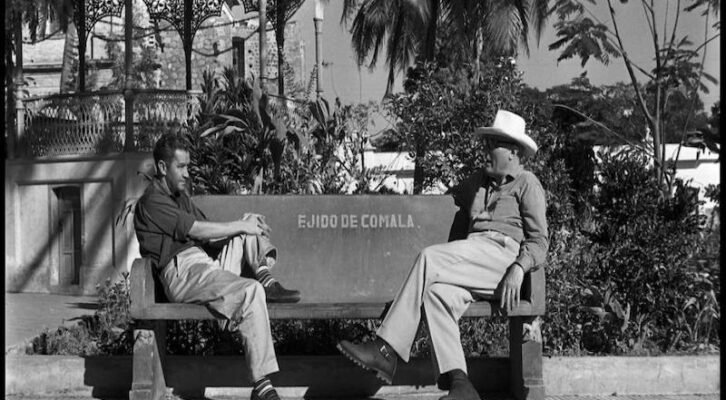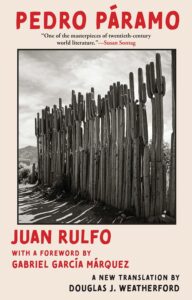
Gabriel García Márquez on the Magic of Juan Rulfo
A Foreword to the Classic Mexican Novel Pedro Páramo
My discovery of Juan Rulfo – like that of Kafa – will without doubt be an essential chapter in my memoirs. I had arrived in Mexico on the same day Ernest Hemingway pulled the trigger – the 2nd of July 1961 – and not only had I not read Juan Rulfo’s books, I hadn’t even heard of him.
It was very strange: first of all because in those days I kept up to date with the latest goings on in the literary world, and even more so when it came to Latin American novels; secondly because the first people I got in touch with in Mexico were the writers who worked with Manuel Barbachano Ponce in his Dracula’s Castle on the streets of Córdoba, and the editors of the literary magazine Novedades, headed up by Fernando Benítez. Naturally, they all knew Juan Rulfo well. Yet it was at least six months before anyone mentioned him to me. Perhaps because Juan Rulfo, contrary to what happens with most great authors, is a writer who is much read but little spoken of.
I lived in an apartment without an elevator on calle Renán in the Anzures neighbourhood of Mexico City with Mercedes and Rodrigo, who was less than two years old at the time. There was a double mattress on the floor of the master bedroom, a crib in the other room, and a kitchen table which doubled as a writing desk in the living room, with two single-seat chairs which were put to whatever use was needed. We had decided to stay in this city which at that time still retained a human scale, with its diaphanous air and deliriously coloured flowers in the avenues, but the immigration authorities didn’t seem inclined to share in our happiness. Half our lives were spent in immobile queues, sometimes in the rain, in the penitents’ courtyards of the Secretariat of the Interior.
In my free hours I wrote notes on Colombian literature which I read out live on air for Radio Universidad, then under the auspices of Max Aub. These notes were so honest that one day the Colombian ambassador phoned the broadcaster to lodge a formal complaint. According to him, mine were not notes on Colombian literature, but against Colombian literature. Max Aub called me to his office, and that, I thought, was the end of the only means of income I had managed to secure in six months. In fact, precisely the opposite happened.
“I haven’t had time to listen to the program,” Max Aub told me. “But if it’s as your ambassador says, then it must be very good.”
I was thirty-two years old, had in Colombia an ephemeral journalistic career, had just spent three very useful and difficult years in Paris, and eight months in New York, and wanted to write screenplays in Mexico. The Mexican writing community at that time was similar to Colombia’s, and I felt very much at home there.
Six years earlier I had published my first novel, Leaf Storm, and I had three unpublished books: No One Writes to the Colonel, which appeared around that time in Colombia; In Evil Hour, which was published by the publishing house Editorial Era shortly afterwards on the recommendation of Vicente Rojo and the story collection Big Mama’s Funeral. Of this last I had only incomplete drafts, since Álvaro Mutis had lent the originals to our much-loved Elena Poniatowska before my arrival in Mexico, and she had lost them. Later I managed to reconstruct the stories, and Sergio Galindo published them at the University of Veracruz on the recommendation of Álvaro Mutis.
So I was already a writer with five underground books. For me that wasn’t a problem, since neither then nor ever have I written for fame, but rather so that my friends would love me more, and I believed I had managed that. My great problem as a novelist was that after those books I felt I had driven myself up a blind alley, and I was looking everywhere for an escape route. I was well acquainted with good authors and bad authors alike who could have shown me the way out, and yet I felt myself going around and around in concentric circles. I didn’t see myself as spent.
On the contrary: I felt I still had many novels in me, but I couldn’t conceive of a convincing and poetic way of writing them. That is where I was when Álvaro Mutis climbed with great strides the seven storeys up to my apartment with a bundle of books, extracted from this mountain the smallest and shortest, and said as he laughed himself to death:
“Read this shit and learn!”
The book was Pedro Páramo.
That night I couldn’t sleep until I had read it twice. Not since the awesome night I read Kafka’s Metamorphosis in a down-at-the-heels student boarding house in Bogotá – almost ten years earlier – had I been so overcome. The next day I read The Plain in Flames, and my astonishment remained intact. Much later, in a doctor’s waiting room, I came across a medical journal with another of Rulfo’s scattered masterpieces: The Legacy of Matilde Arcángel’. The rest of that year I couldn’t read a single other author, because they all seemed inferior.
I still hadn’t escaped my bedazzlement when someone told Carlos Velo that I could recite from memory whole passages of Pedro Páramo. The truth went even further: I could recite the entire book front to back and vice-versa without a single appreciable error, I could tell you on which page of my edition each scene could be found, and there wasn’t a single aspect of its characters’ personalities which I wasn’t deeply familiar with.
That night I couldn’t sleep until I had read it twice. Not since the awesome night I read Kafka’s Metamorphosis in a down-at-the-heels student boarding house in Bogotá – almost ten years earlier – had I been so overcome.
Carlos Velo entrusted me with the adaptation for cinema of another of Juan Rulfo’s stories, the only one which I hadn’t yet read: ‘The Golden Cockerel’. There were sixteen pages of it, very crumpled, typed on disintegrating tissue paper by three different typewriters. Even if they hadn’t told me who it was by, I would have known straight away. The language wasn’t as intricate as the rest of Juan Rulfo’s work, and there were very few of his usual literary devices on show, but his guardian angel flew about every aspect of the writing. Later, Carlos Velo and Carlos Fuentes asked me to read and critique their screenplay for a film adaptation – the first – of Pedro Páramo.
I mention these two jobs – the results of which were a long way from being any good – because they obliged me to dive even further into a novel which without doubt I knew better than even its own author (who, by the by, I didn’t meet until several years later). Carlos Velo had done something striking: he had cut up the temporal fragments of Pedro Páramo, and had reassembled the plot in strictly chronological order. As a straightforward resource to work from it seemed legitimate, although the resulting text was vastly different from the original: flat and disjointed. But it was a useful exercise for me in understanding Juan Rulfo’s secret carpentry, and very revealing of his rare wisdom.
There were two fundamental problems with adapting Pedro Páramo for screen. The first was the question of names. As subjective as it sounds, in some way every name resembles the person who bears it, and this is something that is much more obvious in fiction than in real life. Juan Rulfo has said – or is claimed to have said – that he takes his characters’ names from the headstones of the graves in the cemetery at Jalisco. The only thing we can be certain of is that there are no proper nouns as proper – which is to say, as appropriate – as those borne by the characters in his books. It seemed impossible to me – indeed, it still seems impossible – that an actor could ever be found who would perfectly suit the name of the character he was to play.
The other problem – inseparable from the first – was that of age. Throughout his work, Juan Rulfo has been careful to take very little care with the lifespans of his creations. The critic Narciso Costa Ros recently made a fascinating attempt to establish them in Pedro Páramo. I had always thought, purely through poetic intuition, that when Pedro Páramo finally takes Susana San Juan to the Media Luna, his vast domain, she is already sixty-two years old. Pedro Páramo must be around five years her senior.
In fact, the whole tragedy seems much greater, much more terrible and beautiful, if the precipitous passion that sets it in motion is so geriatric as to offer no real relief. Such a great and poetic feat would be unthinkable in the cinema. In those darkened theatres, the love lives of the elderly don’t move anyone.
The difficult thing about looking at things in this lovely, deliberate way is that poetic sense does not always tally with common sense. The month in which certain scenes occur is essential in any analysis of Juan Rulfo’s work, something I doubt he was even conscious of. In poetic works – and Pedro Páramo is a poetic work of the highest order – authors often invoke the months of the year for reasons outside strict chronology. What’s more: in many cases an author may change the name of the month, day or even year solely to avoid an infelicitous rhyme, or some disharmony, without recognising that these changes can cause a critic to reach an insurmountable conclusion about the work in question.
This is the case not just with days and months, but with flowers too. There are writers who use them purely for the sophistication of their names, without paying much attention to whether they correspond to the place or season. This is why it is not uncommon to find books where geraniums flower on the beach and tulips in the snow. In Pedro Páramo, where it is impossible to be entirely sure where the line between the living and the dead is drawn, any precision is all the more unattainable. No one can know, of course, how many years death may last.
I wanted to write all this to say that my profound exploration of Juan Rulfo’s work was what finally showed me the way to continue with my writing, and for that reason it would be impossible for me to write about him without it seeming that I’m writing about myself. I also want to say that I read it all again before writing these brief reminiscences, and that once again I am the helpless victim of the same astonishment that struck me the first time around. They number scarcely more than three hundred pages, but they are as great – and, I believe, as enduring – as those of Sophocles.
__________________________________

Pedro Páramo by Juan Rulfo, in a new translation by Douglas J. Weatherford, with a foreword by Gabriel García Márquez translated by N.J. Sheerin, is available from Grove Atlantic and Serpent’s Tail.
© Gabriel García Márquez, 1980 and Heirs Gabriel García Márquez.
Gabriel García Márquez
Gabriel García Márquez was born in Colombia in 1927. He was awarded the Nobel Prize in Literature in 1982. He is the author of many works of fiction and nonfiction, including One Hundred Years of Solitude and Love in the Time of Cholera. He died in 2014.



















